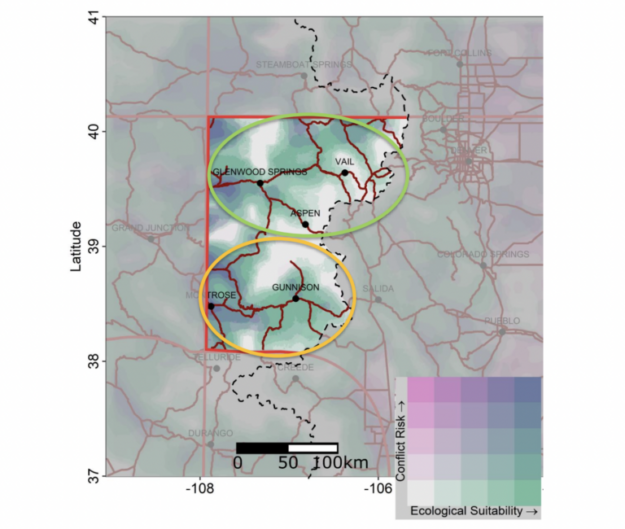Widgetized Section
Go to Admin » Appearance » Widgets » and move Gabfire Widget: Social into that MastheadOverlay zone
Colorado Parks and Wildlife unveils wolf reintroduction plan, including Vail area

Colorado could be less than a year away from the state’s first relocation of gray wolves to parts of the Western Slope, as required by a ballot initiative passed by voters in 2020.
A draft plan released by Colorado Parks and Wildlife last month calls for the reintroduction of 10 to 15 wolves per year over the next three to five years, with an initial target of a stable population of at least 50 animals within the state.
“This draft plan represents the division’s very best effort to develop a blueprint and common-sense approach to implement Proposition 114,” said Carrie Besnette Hauser, chair of the Colorado Parks and Wildlife Commission, at the panel’s December meeting. “The goal was to develop a plan that the majority of the public will support and one that represents reasonable compromise, viability, and has room to evolve over time.”
Voters narrowly approved Proposition 114, a citizen-initiated measure backed by wildlife conservation groups, by a 51% to 49% margin in November 2020. It directed CPW to develop a plan and take steps to reintroduce gray wolves west of the Continental Divide by the end of 2023.
Under the state’s 293-page draft plan, CPW staff will work with counterpart agencies in Idaho, Montana and Wyoming to capture wolves from existing wild populations in those states, and release them on state-owned and private lands at least 60 miles from neighboring state or tribal borders.
Based on criteria of habitat suitability and conflict risk, the plan identifies a northern zone centered on Glenwood Canyon and a southern zone centered on Gunnison County as the best locations for the wintertime releases of captured wolves. The first releases would occur in the northern zone in the winter of 2023-24, and the wolves will be tracked via GPS collars to help wildlife managers gather data on survival and dispersal.
Although the new law includes a provision requiring the state to compensate agricultural producers for any livestock losses caused by wolves, ranchers on the Western Slope and industry groups like the Colorado Cattlemen’s Association have remained wary of the proposal.
The state’s draft plan includes detailed procedures for compensating ranchers for livestock losses of up to $8,000 per animal. Commission Vice Chair Dallas May, a rancher from Lamar, called the plan “a great start” but told state staff that the $8,000 maximum is “insufficient.”

“Many horses and livestock seedstock are much more valuable than that,” May said. “A well-trained young ranch horse — the value of those start at $15,000. Most people have pastures of $15,000 horses that are necessary to operate their business.”
‘A momentous conservation achievement'Gray wolves are native to Colorado and other Rocky Mountain states but were hunted to near-extinction by the mid-20th century. With the support of conservation groups, reintroduction efforts like one in Yellowstone National Park beginning in 1995 have allowed populations to recover in the northern Rockies. Studies have linked wolf reintroduction to a variety of positive effects on impacted ecosystems, like healthier elk herds and the recovery of riparian habitats previously damaged by over-grazing.
Sightings of wolves that have migrated from other states have periodically been reported in Colorado, and the state’s first breeding pair of wolves in 70 years was confirmed in Jackson County in 2021.
Dillon Hanson-Ahumada, a Southern Rockies field representative for the Endangered Species Coalition, said in a statement that CPW’s plan “marks one more step toward a momentous conservation achievement for the wilds and the people of Colorado.”
“The gray wolf is an important native species to our state, and a vital part of the wildlife heritage we all share as Coloradans,” Hanson-Ahumada said. “We will work to ensure that the final plan commits Colorado to a full recovery of wolves now and for future generations of Coloradans.”
Some environmentalists, however, object to the plan’s approach towards livestock-wolf conflicts. Michael Robinson, a senior conservation advocate at the Center for Biological Diversity, said the draft plan “paves the way for far too many wolves to be shot.” Under the plan, many state protections for wolves would expire once the population reaches 200 animals, potentially leading to legal wolf hunting, as states like Montana and Wyoming have allowed.
“This disappointing proposal doesn’t require ranchers to take responsibility for preventing conflicts and will lead to government agents regularly shooting Colorado wolves from helicopters,” Robinson said in a statement. “The commissioners should reject this draft and rewrite the plan based on science.”
CPW staff will hold five public hearings throughout the state in January and February to receive public comment on the draft plan, with a final set of revisions and the plan’s potential approval scheduled for April and May. Members of the public can also submit comment through an online form until Feb. 22.
Editor’s note: This story first appeared on Colorado Newsline, which is part of States Newsroom, a network of news bureaus supported by grants and a coalition of donors as a 501c(3) public charity. Colorado Newsline maintains editorial independence. Contact Editor Quentin Young for questions: info@coloradonewsline.com. Follow Colorado Newsline on Facebook and Twitter.


